Robin Van Auken's Blog
October 13, 2025
‘Island Time’ Began Here
We live on Pine Island, the largest island in Florida. Once upon a time, the little village of Matlacha welcomed us as we drove from the mainland to get home.
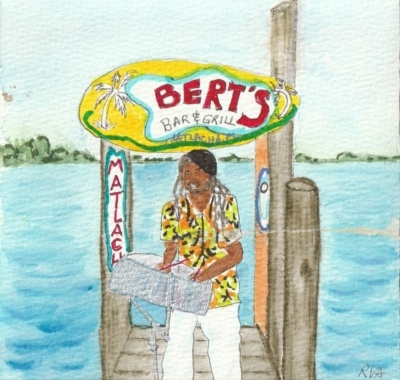
It was a place of sun and color, the narrow ribbon of land between sea and sky. It was a cluster of brightly painted houses, art-filled shops, and weathered docks that bobbed like sleepy sentinels along the saltwater’s edge.
During the high season, winter here in Florida, traffic was stop-and-go as pedestrians crossed the two-lane street to scurry from one shop to the next, purchasing original art, potted plants, fudge, ice cream, T-shirts, and flip flops. Small cafes and large dive bars offered fish sandwiches, margaritas, beer, and Island Pho.
Then, on September 28, 2022, Hurricane Ian swept through. The wind first came as a distant rumble. Soon, waves rose like cliffs, rain fell in curtains, and the horizon vanished in sheets of gray. The villagers watched as the sea lifted.
We huddled in our house, surrounded by protective mangroves, as the wind pulled trees from their roots and shredded neighbors’ roofs and lanais. Miraculously, the storm surge reversed before entering our home. We were safe.
But not everyone else was, and especially not Matlacha. Hurricane Ian killed at least 161 people, 81 in Lee and Charlotte County.
The sea swept over the beaches and into every building along its low-lying shores. Homes were torn open; roofs peeled away like petals. Shops were flooded, their treasures lost or ruined. The storm surge reached deep into the islands and the mainland, leaving ruins in its wake.
At dawn, survivors emerged from shelters, wading through mud and salt, and saw their village transformed into a fractured memory. Many buildings were gone, most were condemned, and some lingered half in the water, reminders of what had been lost.
The bridges connecting Matlacha to the mainland and to Pine Island—its slender lifelines—were battered and washed out. Powerlines toppled and blocked the crumbed roads. We couldn’t escape.
For a week, while the food and fresh water lasted, we cleared debris, cut trees blocking the roads, searched corners of the island for a cell signal, and bathed with filtered pool water. Eventually, we were told to evacuate because the island’s water treatment plant had lost its generator and had no fresh water. None was to be delivered by FEMA, so we joined our neighbors on a boat and left the island. We stayed with family for another two weeks until an emergency bridge span was erected to connect the island, and then returned home.
Locals rallied in solidarity, and for two years, the community rebuilt. Then, in 2024, Hurricanes Helene and Milton made landfall with high winds, high water, and tornadoes, and once again wrecked the communities already struggling to recover. Though Hurricane Ian brought ruin, it could not extinguish the heart of the village.
It’s a story of coastal life, one of bright, golden mornings after the storm. It certainly speaks to the need for bright colors to gradually return. But many scars remained: houses awaiting demolition, parcels of empty land where homes once stood, and delays in removing rubble that made outsiders think the village was dead.
In 2025, Lee County took steps to demolish dozens of unsafe structures, placing legal liens and advancing rebuilding efforts. This is possible because, for 360+ days out of the year, the scenery is beautiful, and island living is a thrill. People will return and spend their money, attracting more people to spend their money and enjoy another morning after.


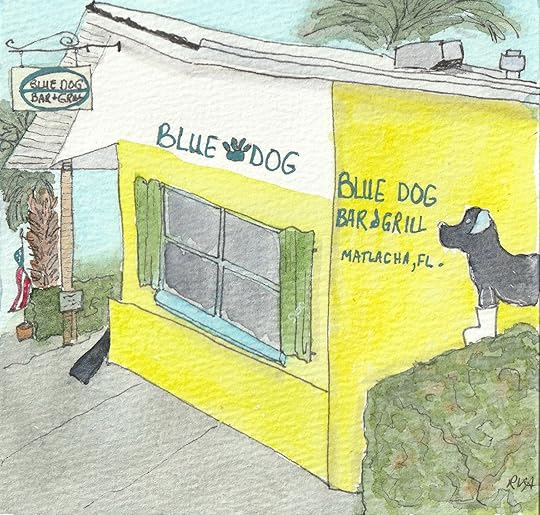

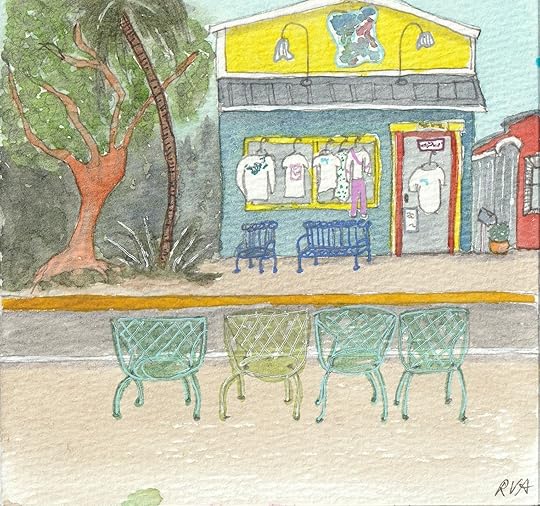
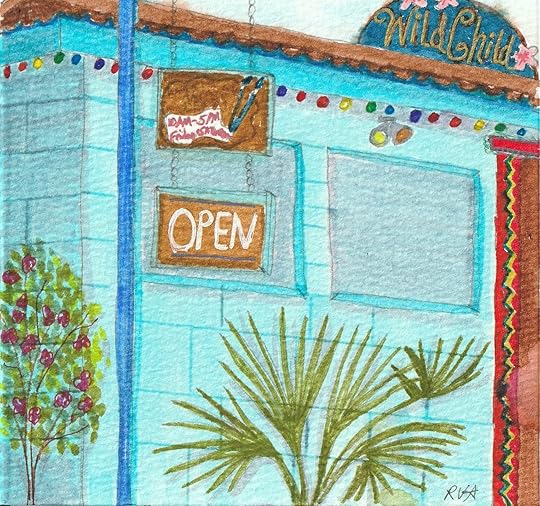

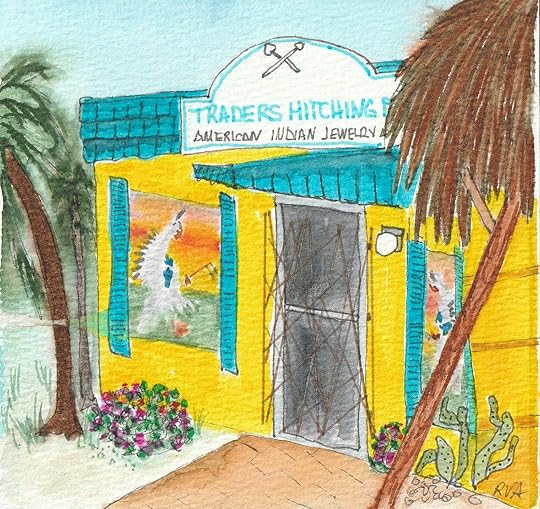
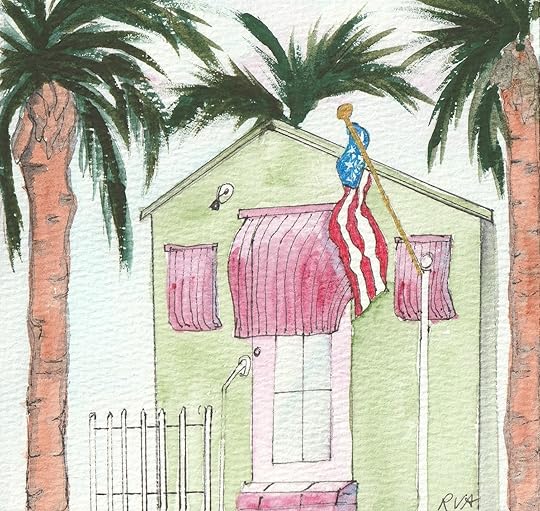
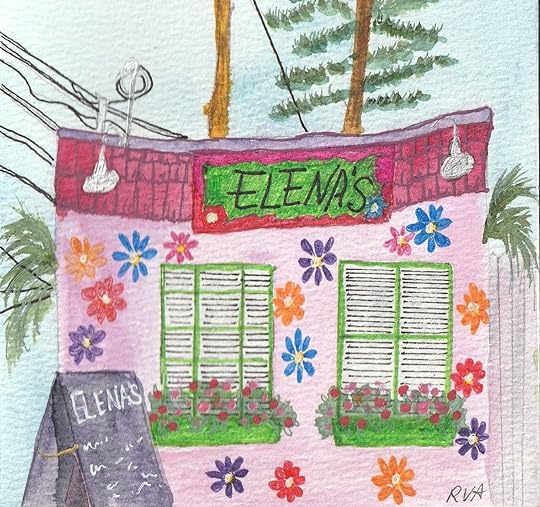

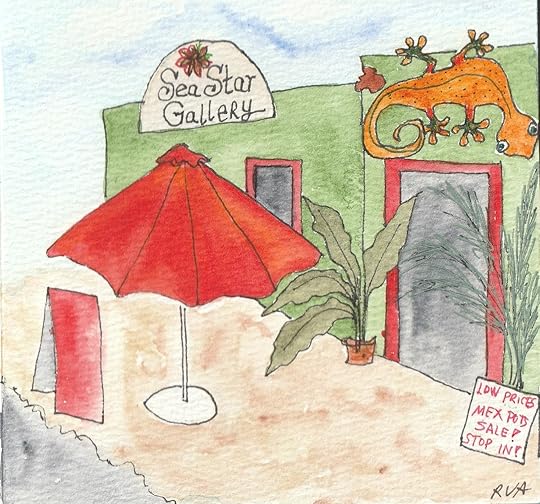
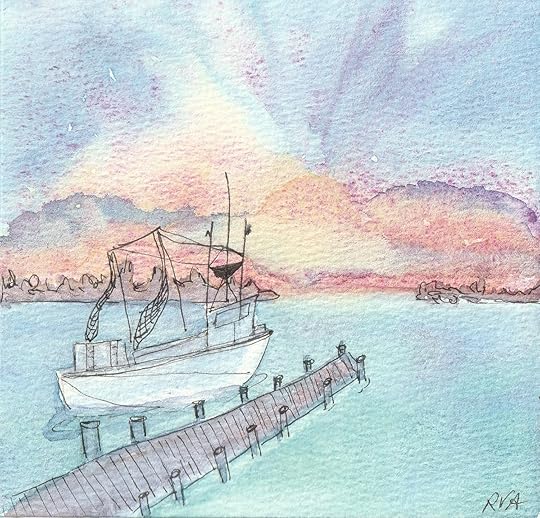
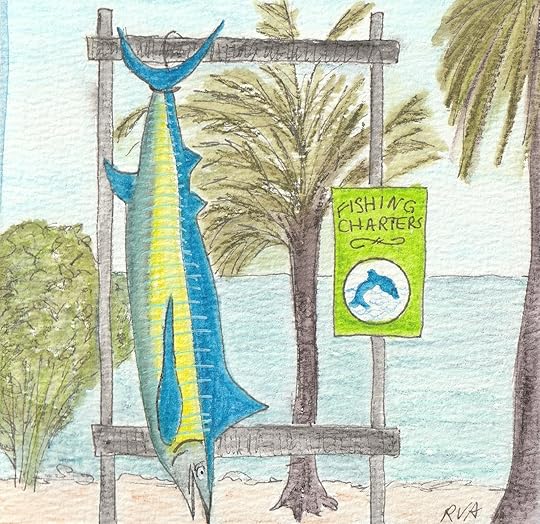 I created a small memento for my friend, Penny Morse, that will remind her of what she loves about “Island Time” and living on Pine Island. This small booklet features urban sketches of pre-Hurricane Ian Matlacha.Ready for a Challenge?
I created a small memento for my friend, Penny Morse, that will remind her of what she loves about “Island Time” and living on Pine Island. This small booklet features urban sketches of pre-Hurricane Ian Matlacha.Ready for a Challenge?
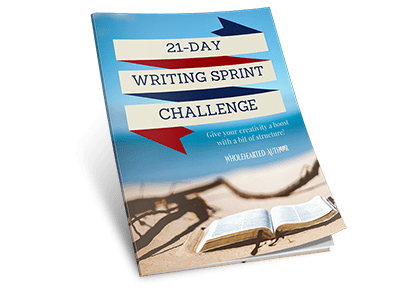 Accept the Challenge
Accept the ChallengeHave even more fun when you accept the 21-Day Writing Sprint Challenge. This process is one I use every semester with my college students, so I know it can kickstart your creativity and introduce structure to your writing schedule. When you join my Circle of Writers & Authors, you’ll receive FREE writing resources, and you’ll sign up for my newsletter. I will not sell your information, or spam you. I will send you updates about new articles and podcasts I’ve created, and projects I’m working on. You can unsubscribe at anytime. Read my Privacy Policy here.
Wholehearted Author is for you if you are …Starting out as a writer and could use some guidanceWanting to be inspired to create and publish your bookLooking for like-minded, happy people and helpful mentorsHoping to turn your writing into a full-time, awesome careerNew to the concept of “permission marketing” but willing to try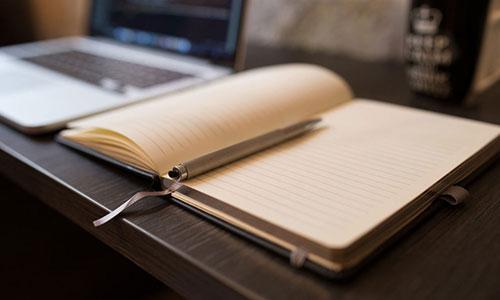 Send My Free Writing ResourcesCATCH THE WEST WINDAdd WEST WIND to your library!
Send My Free Writing ResourcesCATCH THE WEST WINDAdd WEST WIND to your library!If you love a good mystery, a romantic whodunit that will surprise you, then WEST WIND is a great addition to your ebook library.
West Wind is my third novel as an author of Contemporary Fiction, Suspense, Thriller, and Romance. It’s FREE too, when you join my exclusive Readers Group. Join today and download your free book, and as a special thank you, you’ll receive a SECOND FREE BOOK tomorrow! The giving goes on and on when you become my fan.
When you join my Readers Group, you’ll receive updates about new projects I’m working on. You can unsubscribe at anytime. Read my Privacy Policy here.
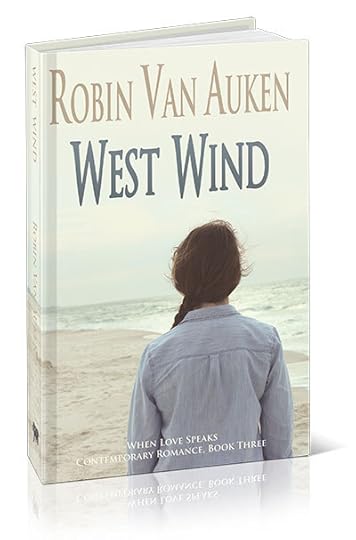 DOWNLOAD WEST WIND
DOWNLOAD WEST WINDThe post ‘Island Time’ Began Here appeared first on Hands-on Heritage.
August 15, 2024
Crafting Your World with Bullet Journals
My desk drawers and closets contain many notepads, notebooks, and journals. It’s how I’ve always collected my thoughts. I consume a lot of paper, and my notepads are mostly random, disjointed, and illegible. I take a lot of notes in meetings—the brain dump of a technical writer. I seldom look back through them because they are there to create an impression, and I’m great at memorization.
My journals, however, are different. These are personal and lengthy, even though the handwriting is still illegible. These are the stories of my life written intermittently and with no elaboration or celebration. They’re generally nondescript books of all sizes and colors and seem to be purchased spontaneously. But this is changing. During the past few years, I’ve been learning more about art and how to draw and paint watercolors. Lately, these sketches and colors are bleeding into my notebooks and journals.
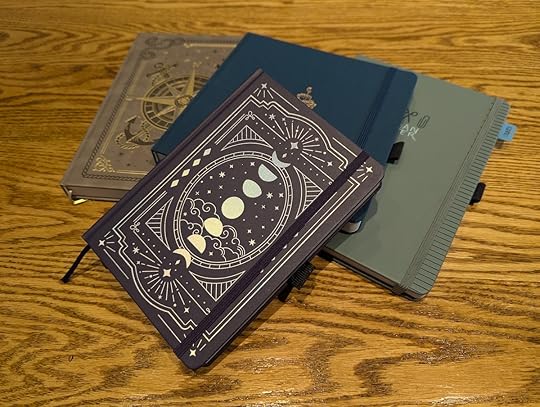
Crafting Your World with Bullet Journals: A Comprehensive Guide for BUJO Beginners – Hands-on Heritage
I hadn’t imagined a canvas where productivity could meet creativity. A space where my thoughts and tasks could share a page with art. Then, I discovered the world of illustrated traveler’s notebooks and bullet journals.
What Are Bullet Journals?Bullet journals are blank notebooks that people transform into personalized planners, diaries, and trackers. They use a system of calendars, bullets, short phrases, and simple symbols to log information quickly. Digital product designer Ryder Carroll developed the system to keep his ideas organized, and his method has gained popularity for managing tasks, goals, and ideas.
I dove into the deep end and added new art supplies to my online shopping cart. Soon, my storage bins became crowded with blank dot-grid books of various sizes, stickers, stencils, colorful brush pens, fine-liner pens, cutting mats, stamps, ink pads, stationery paper, washi tape, corner-cutting tools, knives, tweezers, glue sticks, glue dots, and glue pens. The inventory continued to grow.
My Instagram account, formerly dominated by watercolorists, embraced travel art journal users and bullet journalers. I began watching anyone who included the word “plan” in their account name. I had to examine what this world offers and learn the secret of easily peeling the back off the stickers.
I’m no expert, and my amateur attempts at duplicating the examples I see are laughable, but I’m embracing the fun aspect of learning new skills.
If you want to know more about the process, keep reading. What follows is a comprehensive overview of the BUJO—or Bullet Journal—world.
The Art of Organization: Where Function Meets Beauty

At its heart, the art of organization in bullet journaling is about creating a system that keeps you on track and inspires you to engage with your plans and goals—finding a balance between structure and flexibility, productivity, and creativity. As you develop your system, you’ll find that organizing becomes a meditative and enjoyable process, turning planning into a form of self-care and personal expression.
Here’s how you can master this art:
Index and NumberingMaintain an index at the front of your journal and number your pages. This simple system ensures you can always find what you need, no matter how creative or complex your journal becomes. I messed this one up right away. I should have given myself an extra page, as the index grew.
Signifiers and KeysDevelop a set of symbols or icons to quickly mark the status or nature of tasks. For example, you could use a star for priority items, a circle for events, or an exclamation mark for essential notes. Create a key page to remember your system and put it in your index section.
Personalized LayoutsEvery person’s needs are unique, and bullet journals shine in their adaptability. Experiment with different layouts—weekly spreads, monthly overviews, or daily pages—until you find what works best. The beauty lies in the freedom to adjust your system as your life evolves. I’m still dialing this advice in. I currently have three books that I’m updating since I’m not sure which layout will work best for me.
CollectionsCreate dedicated pages—or collections—for specific topics or projects. These collections can house everything from book lists and travel plans to long-term goals and project brainstorms. The key is to make these pages both functional and visually engaging.
Color-CodingIntroduce a color system to categorize tasks, events, or areas of your life. This visual shorthand allows you to grasp the nature of your commitments at a glance. For instance, blue could be used for work tasks, green could be used for personal errands, and purple could be used for social events. As an introvert, I don’t need the green or purple since I rarely venture out on errands and don’t plan social events.
Habit TrackersDesign visually appealing habit trackers to monitor and encourage positive behaviors. These can be anything from drinking enough water to practicing mindfulness. I have included a Swim Log in my book since I try to exercise in my pool every day. Watching the tracker fill up over time provides a satisfying visual representation of progress.
MigrationEmbrace the practice of “migration”—moving unfinished tasks forward to new pages or reassessing their relevance. This keeps your journal current and prevents you from getting bogged down by outdated to-dos. Since I’ve started several books simultaneously, I’m jumping from one book to the next to keep them updated. I won’t make this mistake for BUJO No. 4.
Chapter Topic Ideas for Bullet Journals
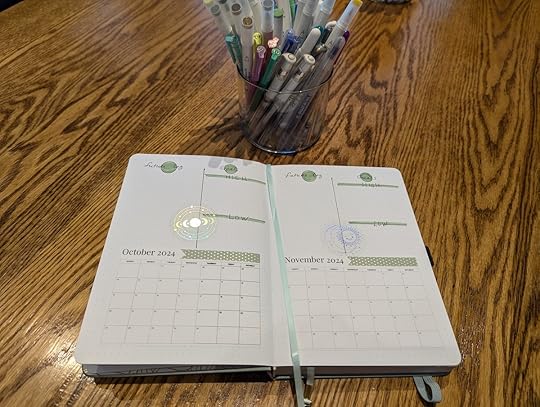
Because I was so excited to get started, I didn’t think about how to create chapters in my bullet journal. I am learning that these chapters represent different aspects of my life. Don’t do the same. Consider designing each section to create a visual language that speaks to that area.
Here’s an expanded look at how to design chapters:
Work and ProjectsLayout: Create structured grids and timelines using fine-line black markers for a clean, professional look.
Color Scheme: For a polished feel, stick to a limited palette of muted colors like navy, gray, and burgundy.
Elements: Include mini calendars, project trackers, and goal-setting pages.
Embellishments: Use geometric shapes and minimalist icons to maintain a sleek appearance.
Personal GoalsLayout: Design more fluid, open layouts for reflection and growth.
Color Scheme: Employ watercolor brush markers in soft, inspiring hues like pastels or earthy tones.
Elements: Incorporate vision boards, habit trackers, and motivational quotes.
Embellishments: Add stickers of flowers or leaves for a natural, organic feel.
Hobbies and InterestsLayout: Create playful, asymmetrical designs that reflect the joy of your pastimes.
Color Scheme: Use vibrant, bold colors that capture the excitement of your interests.
Elements: Include logs for books read, movies watched, or skills learned.
Embellishments: This is where washi tape and doodles can truly shine.
Health and WellnessLayout: Design calming, spacious layouts that encourage mindfulness.
Color Scheme: Use soothing blues, greens, or warm, comforting tones.
Elements: Add meal planners, exercise logs, and mood trackers.
Embellishments: Incorporate mandalas or zentangles for a meditative touch.
FinanceLayout: Create structured tables and charts for precise financial tracking.
Color Scheme: Use green accented with neutral tones for a focused feel.
Elements: Include budget trackers, savings goals, and expense logs.
Embellishments: Use simple line drawings of coins or bills as subtle decorations.
Travel and AdventuresLayout: Design layouts that evoke maps and journeys.
Color Scheme: Use a diverse palette inspired by different destinations.
Elements: Create packing lists, itineraries, and souvenir collection pages.
Embellishments: Add travel-themed washi tape, ticket stubs, stickers, and small sketches of landmarks.
Creativity and LearningLayout: Design open, free-form layouts that encourage brainstorming and exploration.
Color Scheme: Use a rainbow palette to represent the full spectrum of creative thought.
Elements: Include skill progress trackers, idea banks, and learning logs.
Embellishments: Experiment with mixed media, collage, or your artwork.
Designing Bullet Journal Chapters
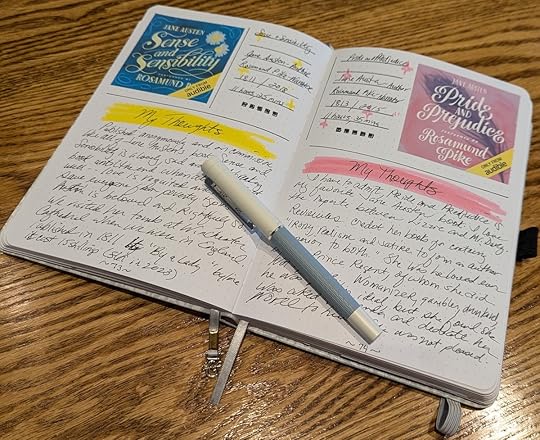
I hope you’re still reading and haven’t jumped into your journal with all the crafty things spread about you!
Before using the elements and embellishments mentioned above, think about creating cohesion across your bullet journal chapters. By weaving a visual narrative, you ensure that while each section is unique, your journal feels unified. It’s too late for my first few books, but this is what I plan to do for BUJO No. 4.
Here’s how to achieve this balance:
Consistent Color Palette: Choose an overarching color scheme for your journal and assign specific colors to each chapter, ensuring they complement the primary palette. Use these colors consistently in each chapter’s headers, borders, and accents.
Unified Typography: Select a primary font or handwriting style for headers across all chapters to maintain consistency. Choose complementary fonts or handwriting styles for subheads and body text, and create a typography guide page.
Recurring Motifs: Develop a set of icons or symbols that represent each chapter, and use these motifs on chapter title pages and as small accents throughout. Consider a unifying theme (e.g., nature, geometric shapes) across chapters.
Standardized Layout Elements: Design a consistent header or footer for all pages. Use similar page numbering styles throughout and maintain consistent margins and grid systems across chapters.
Transitional Pages: Create buffer pages between chapters that blend elements from both. Use these pages to shift color schemes or design styles gradually.
Signature Borders: Design a borders set that can be used across all chapters. Vary the colors of these borders to match each chapter’s theme.
Consistent Use of Materials: If you use washi tape, choose a core set that appears throughout the journal. Select a primary set of markers or pens to use across all chapters.
Chapter Tabs or Dividers: Create visually distinct but stylistically similar tabs for each chapter. Use these for easy navigation while maintaining visual cohesion.
Repeating Patterns: Develop a set of background patterns adapted to each chapter’s theme. Use these patterns sparingly to tie different sections together.
Consistent Mood and Tone: While each chapter may have its own feel, the overall mood should be consistent. This could be minimalist, whimsical, vintage, or any style that resonates with you.
Unifying Framework: Create a template for chapter title pages and use it consistently. This might include a specific layout, title style, and decorative elements.
Cross-Chapter References: Design a cross-referencing system that visually links related items in different chapters. This could be through color-coding, symbols, or page number styles.
Seasonal or Thematic Variations: If your journal spans an extended period, consider subtle seasonal changes that affect all chapters. This creates cohesion while allowing for natural evolution in your designs.
Consistent Review and Reflection Pages: Design standardized monthly or quarterly review pages in each chapter. These act as anchors, tying the journal together at regular intervals.
How to Use Washi Tape in Your Bullet Journal
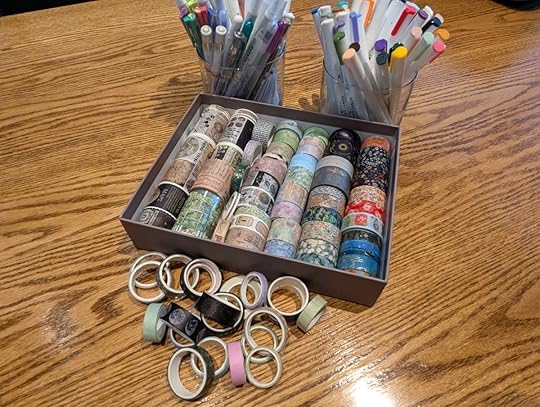
Originally from Japan, washi tape has become a staple in the bullet journaling community. Its versatility, ease of use, and wide array of designs make it an indispensable tool for journal enthusiasts. Silly me—I was using my washi tape on the borders of my watercolor paper as if it were masking tape used to create crisp lines between my painting and the edge. Once the painting was dry, I peeled up the washi tape and tossed it. I didn’t realize it had a different purpose. I didn’t think to leave it on the paper and consider it an embellishment.
The magic of washi tape lies in its ability to instantly add color, pattern, and texture to your bullet journal pages. It’s a low-pressure way to decorate and organize, perfect for seasoned artists and those just starting their bullet journal journey. With creativity, washi tape can elevate your journal from functional to fantastical.
Here’s an expanded look at how to use washi tape in your bullet journal:
Borders and Dividers: Use washi tape along the edges to create instant page borders. Use thin strips to separate different sections on a page and layer different patterns and widths for more complex borders.
Headers and Titles: Use wide washi tape as a background for page titles. Cut the tape into banner shapes for eye-catching headers or layer different tapes to create unique title designs.
Decorative Backgrounds: Create patterns by laying down strips of washi tape at angles. Use it to cover entire pages for instant themed backgrounds or tear the tape for a more organic, textured look.
Color Coding: Assign different washi tape patterns to various categories in your journal. Use small pieces of tape as colorful bullet points, or create a key using the tape to explain your color-coding system.
Tabs and Bookmarks: Fold washi tape over page edges to create easy-to-flip tabs. Use decorative scissors to cut washi tape into unique tab shapes, and make removable bookmarks by sticking the tape to paper clips.
Framing Elements: Use washi tape to create frames around important notes or quotes. Make photo corners with washi tape to display pictures or ephemera, and create washi tape polaroid frames for a vintage look.
Calendar Embellishments: Highlight important dates with small washi tape flags. Create a tape grid for monthly layouts, and use patterned tape to mark weekends or holidays.
Mood Trackers: Design mood trackers using different washi tape patterns for each emotion. Create a color scale for more nuanced mood tracking.
Habit Trackers: Use small pieces of washi tape to mark completed habits or create colorful habit tracker grids using tape strips.
Pocket Creation: Fold washi tape and adhere it to pages to make small pockets. Use these pockets to store small mementos or extra notes.
Layering and Texture: Layer different washi tapes for added depth and texture. Combine matte and glossy tapes for interesting visual effects.
Washi Tape Collages: Create entire illustrations using only washi tape or combine tape with other media for mixed-media art pages.
Customizing Plain Elements: Use washi tape to decorate plain pens or pencils. Cover the spine of your journal with washi tape for a personalized touch. Use the tape on a bookmark and then laminate or protect it with packing tape.
Correcting Mistakes: Use washi tape to cover up mistakes or unwanted elements in your journal. This allows for easy fixes without ruining your page layout.
Seasonal Themes: Switch up your washi tape selection to match the seasons or holidays. Create themed collections using season-specific tape designs.
5 Tips for Working with Washi TapeKeep scissors, an X-ACTO blade, or a tape dispenser handy for clean cuts.Test the tape’s adhesive strength on a separate page to avoid damaging your journal.Store your washi tape collection in a clear container for easy access and inspiration.Don’t be afraid to mix and match patterns and widths for unique effects.Remember that washi tape is removable and repositionable, allowing for experimentation!Creative Additions to Bullet Journaling
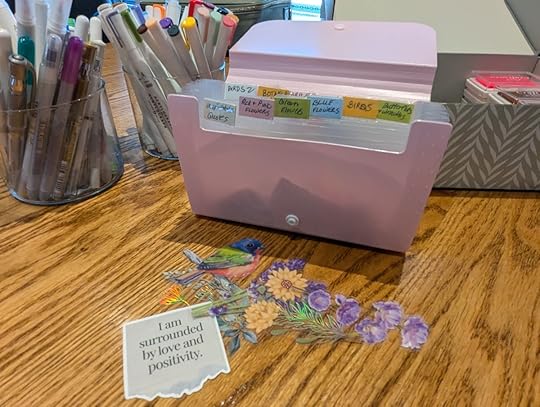
Some artists like to create Junk Journals, but I’m not interested in that reportage style. But if you want the look and feel of a junk journal, these additional aspects can add depth and variety to your bullet journaling practice, allowing for more personalization and creativity. They encourage exploration beyond traditional planning and organization, turning your journal into a multifaceted tool for self-expression, learning, and personal growth.
For example, I created a journal for a museum research project I’m helping develop. I made stickers of architectural drawings of exhibits and used my art pens to sketch visuals. I am using another journal as a diary for the main character of a YA novel I am writing. This one incorporates steampunk elements and is set in the mid-1800s, so I printed vintage newspaper clippings of historical events that the character encounters.
I have a self-care journal, a gratitude journal, and one featuring audiobook reviews since these books aren’t visible on my bookcase. I like the idea that there’s room for creative additions, and here are a few that I may try in my notebooks:
Interactive ElementsCreating flip-ups or fold-out sections for hidden informationDesigning spinner wheels for decision-making or trackingAdding envelope pockets for storing ephemera or additional notesMindfulness and Self-reflectionIncorporating guided journaling promptsCreating mandalas or zentangles for stress reliefDesigning meditation logs or gratitude spreadsData VisualizationCreating unique infographics to represent personal dataDesigning creative pie charts or bar graphs for goal-trackingUsing visual metaphors to represent progress (e.g., growing plants)Theme-based JournalingDesigning entire journals around a specific theme (e.g., space exploration, vintage travel)Creating monthly themes that influence layout and decoration choicesIncorporating elements from pop culture or literature into your designsIncorporating PhotographyUsing instant cameras to add photos directly to your journalCreating photo collages to represent memories or goalsDesigning layouts that blend sketches with photographsStorytelling and Memory-KeepingUsing comic-style layouts to document eventsCreating illustrated timelines of essential life momentsDesigning “day in the life” spreads with detailed illustrationsExploring Calligraphy and LetteringIncorporating different lettering styles for headers and quotesCreating entire spreads focused on practicing calligraphyDesigning custom alphabets for your journalSeasonal and Nature JournalingCreating trackers for plant growth or bird watchingDesigning spreads that change with the seasonsIncorporating pressed leaves or flowers into your layoutsMusic and Sound IntegrationDesigning creative playlist trackersCreating visual representations of favorite songs or albumsIncorporating sheet music into your designsCultural ExplorationDedicating spreads to learning new languagesCreating layouts inspired by different cultural art stylesDesigning travel-inspired spreads for armchair explorationScientific and Educational ElementsIncorporating diagrams or sketches to aid in learningCreating spreads dedicated to documenting experiments or observationsDesigning layouts that explain complex concepts visuallyA Few Fun Supplies for Bullet Journaling and Art
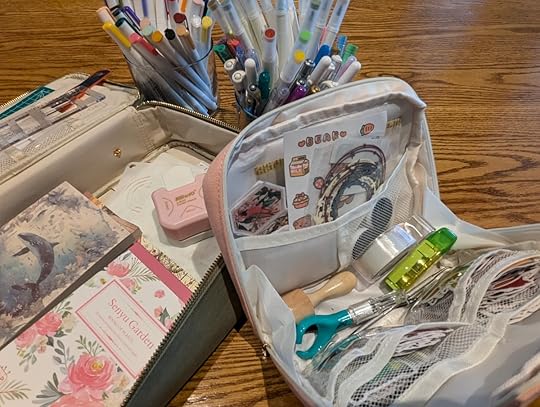
Here are just a few of the art supplies I use for my bullet journals and other journals:
BooksThe Laws Guide to Nature Drawing and JournalingHow to Journal Like an Artist: A Beginner’s Guide to Keeping a Sketch JournalCases & CaddiesAccurasee Sketch CaddieHeavy Duty Tool Bag 15-Inch, 16-Pocket ToteDIYOMR 24/36/72 Slots Pencil Wrap Pencil RollsKOKUYO Neo Critz Pen Case, Large SizeLoustni Collapsible Travel CupSketch Pads and JournalsU.S. Art Supply 5.5″ x 8.5″ Watercolor BookMEEDEN 10X7″ Cotton Watercolor Paper BlockScribbles That Matter A5 Dotted Journal NotebookPencils, Pens, and PaintsPentel® Sharp™ Automatic Drafting Pencils, 0.9 mmDerwent Inktense Pencils Tin, Set of 12Castle Art Supplies 72 Colored Pencils SetFaber Castell F110012 Polychromos Colour PencilsSAKURA Pigma Micron Fineliner Pens – Archival Black Ink PensUni-Ball UM 153 Signo Broad Point Gel Pen – WhiteFaber-Castell Pitt Artist PenHongdian 1862 Fountain Pen, Iridium Fine Nib with Ink ConverterUni-Ball Signo Gel Ink Pens -Medium Point 1.0mm-gold & Silver & White InkTombow 56189 Dual Brush Pen Art MarkersDerwent Push Button Waterbrush Assorted SetDerwent Inktense Paint 12 Pan PaletteKuretake Zig Watercolor System Brush2ODaniel Smith Watercolor: Jean Haines Master Artist Set 10 Watercolor TubesDerwent Graphitint Paint 12 Pan PaletteDerwent Inktense Paint 12 Pan PaletteWinsor & Newton Cotman Watercolor Paint SetBullet Journalers to FollowWhile it’s great to draw inspiration from others, the true beauty of bullet journaling lies in creating a system that works uniquely for you. But, if you’re like me and are totally new to bullet journaling, having YouTube and Instagram can be a big help. I’ve spent most of my life in the black-and-white world of the writer, never adding color or expression beyond the occasional exclamation point. Because of this, I’ve made it my mission to find and follow many creative people in my quest to learn all things arty-farty.
Perhaps you’re already following artists who inspire you. If not, consider this list of people popularizing and developing the bullet journal world:
The original creator of the Bullet Journal methodAuthor of The Bullet Journal MethodKnown for his minimalist approachPopular for her colorful and artistic spreadsOffers courses and products related to bullet journalingYouTube creator known for her artistic and aesthetically pleasing designsOffers monthly plan-with-me videos and stationery reviewsKnown for her clean layouts and informative posts about productivityMember of the Planner Pals podcast along with Mark Your PagesCreates themed monthly spreads often inspired by nature and literatureIllustrator making videos about bullet journalingOperates a stationery shop with monthly themes and journaling kitsNot a single person, but a stationery store with an affection for East Asian culture and a mission to create a space for everyone to feel more creative and at peace. Every product aims to bring you joy and calm in your brightest and darkest moments.Not a single person, but a stationery store launched by Bonnie Kuhl, who struggled to prioritize mental wellness while navigating the day-to-day. Once she discovered that art and journaling helped her feel more in control of her mental health, she set out to share this with as many people as possible.And a few ladies making BUJOs, selling stickers, and more on Instagram:
Amy @amyplansthingsLouise @doodlelou.coKarine @planningwithkElena @ohnoelbujoMandy @mandyjournalsBumble (Okay, so Bumble is her dog) @planningwithbumbleOver to you! What are your favorite layouts, themes, and tips for fellow journalers if you’ve gotten into bullet journaling?
Ready for a Challenge? Accept the Challenge
Accept the ChallengeHave even more fun when you accept the 21-Day Writing Sprint Challenge. This process is one I use every semester with my college students, so I know it can kickstart your creativity and introduce structure to your writing schedule. When you join my Circle of Writers & Authors, you’ll receive FREE writing resources, and you’ll sign up for my newsletter. I will not sell your information, or spam you. I will send you updates about new articles and podcasts I’ve created, and projects I’m working on. You can unsubscribe at anytime. Read my Privacy Policy here.
Wholehearted Author is for you if you are …Starting out as a writer and could use some guidanceWanting to be inspired to create and publish your bookLooking for like-minded, happy people and helpful mentorsHoping to turn your writing into a full-time, awesome careerNew to the concept of “permission marketing” but willing to try Send My Free Writing ResourcesCATCH THE WEST WINDAdd WEST WIND to your library!
Send My Free Writing ResourcesCATCH THE WEST WINDAdd WEST WIND to your library!If you love a good mystery, a romantic whodunit that will surprise you, then WEST WIND is a great addition to your ebook library.
West Wind is my third novel as an author of Contemporary Fiction, Suspense, Thriller, and Romance. It’s FREE too, when you join my exclusive Readers Group. Join today and download your free book, and as a special thank you, you’ll receive a SECOND FREE BOOK tomorrow! The giving goes on and on when you become my fan.
When you join my Readers Group, you’ll receive updates about new projects I’m working on. You can unsubscribe at anytime. Read my Privacy Policy here.
 DOWNLOAD WEST WIND
DOWNLOAD WEST WINDThe post Crafting Your World with Bullet Journals appeared first on Hands-on Heritage.
July 15, 2024
Let’s Learn About Urban Sketching
We love photos and souvenirs from our travels. They’re a wonderful way to bring our journey home and remind us of our adventures.
But what about getting more creative?
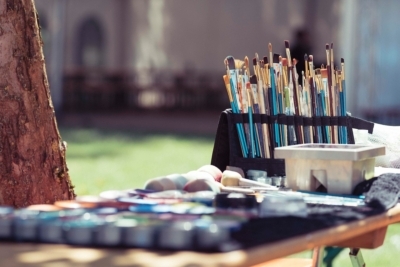
Learn About Urban Sketching: A Creative Way to Capture the Essence of City Life
If you’re an artistic type, or if you’re interested in trying a clever new hobby, you might love urban sketching!
Picture this: you’re at a little cafe enjoying an espresso and people-watching, laptop closed and phone turned over, and you’ve got a perfectly sharpened pencil and clean pad of paper.
Soak in the scenes around you and let them inspire you to draw something: it might be a couple sitting catty-corner to you, an intricate detail of a building you find beautiful, or even a happy dog on his twice-a-day walk. It could be an abstract doodle of the hustle and bustle of the streets, a forceful illustration of the tall buildings surrounding you, or a cozy vignette you want to capture your way.
Urban sketching is a dynamic way to capture street scenes and city life in the pages of your journal or sketchpad. This practice is more than just drawing—it’s about experiencing and preserving the essence of a place.
What is Urban Sketching?I’m a massive fan of “wonky” urban sketching. I know the mission of global urban sketchers is to draw what you see and to “report” in a journalistic fashion. But I think seeing the world in a uniquely colorful and out-of-kilter way is so much more fun! Ian Fennelly is a master of this craft, and I take his online classes, buy his books, and try, not as successfully, to harness the inner “wonk.”
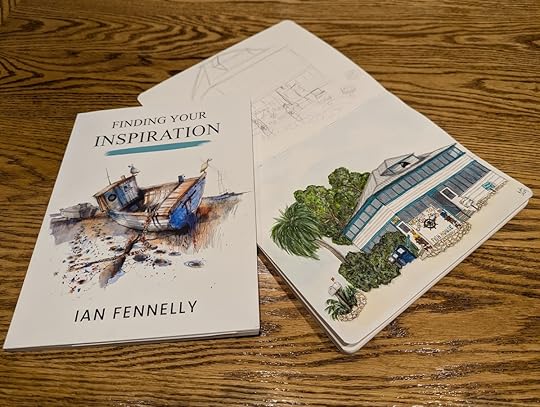
I am so glad I sketched this building. In October 2024, Captain Con’s was destroyed by two back-to-back hurricanes, Helene and Milton. A Pine Island favorite, the restaurant served ice-cold beer, fresh seafood, and homemade pies.
This sketch is of a century-old restaurant on the edge of an island in Florida. It has such charm and character despite myriad tropical storms and hurricanes. The rugged, clapboard siding is faded and chipped, and the screens shade the wide walkways surrounding both floors. Despite my mostly faithful rendering, it has enough lean and natural distortion as a first start.
Urban sketching is precisely what it sounds like—drawing on location in public places!
Whether in a big city, a small town, or a quaint village, you can create your art with pen and ink, watercolor, colored pencils, or any other artistic medium that will help you encapsulate the spirit of your surroundings. The goal is to convey the atmosphere, architecture, and inhabitants of urban environments through art.
It’s a fantastic way to connect more deeply with your environment and the community. If you’re more of a solo artist, spending time outdoors and focusing on art can help you unwind and unplug—and if you’re looking for fellow creatives or some guidance and ideas, look for local sketching groups who might be meeting up while you’re in town. They’d be delighted to host you!
Why You Might Love Urban SketchingThere are so many reasons to get into urban sketching! You’ll improve your drawing skills, gain a greater appreciation for the details of your environment, spend some time outdoors or in a very cool space you might have passed over otherwise, capture the essence of your travels, and can even make new friends—people are bound to be curious about what you’re working on.
If you’re a beginner, start with simple subjects and embrace your mistakes. It’s a pursuit for you to enjoy, so don’t be hard on yourself or negatively compare your drawings with someone else’s. As Professor Elemental says, “Forget about the outcome; make good art.”
And there’s no shortage of places you can go! Here are a few of our favorite destinations that could be the perfect inspiration for you:
If you love getting lost in large cities, you can’t go wrong with New York, London, Paris, or TokyoFind big cities a bit overwhelming? Well, consider Verona (Italy), Seville (Spain), or Reykjavik (Iceland)Just because it’s called “urban sketching” doesn’t mean you need to be in a huge city—villages like those in the Cotswolds, the Scottish Highlands, and theFrench countryside are perfect for capturing peaceful, idyllic scenesIf you’re traveling outside of the city during your trip, remember to take your sketchpad to any parks, beaches, or other natural areas you visit.How to Get Started with Urban Sketching
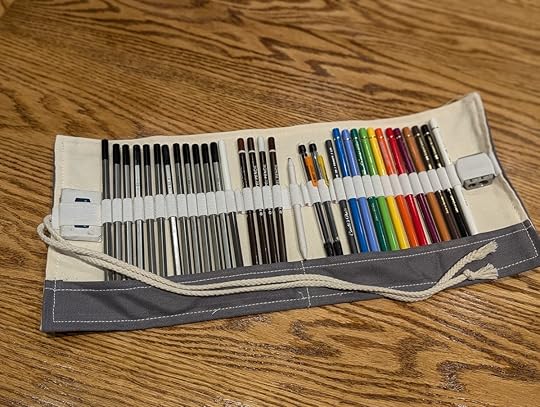
You can start your urban sketching journey with just a notebook and a pencil, but if you’d like to bring more art supplies on your trip, make sure they’re portable!
We love Pentel Sharp Mechanical Drafting Pencils, Sakura Pigma Micron fine-liner pens, and Tombow’s Mono Zero erasers. Tombow’s Dual Brush Pen markers add shadow and depth to your sketches. If you love using watercolor in your urban sketches, we recommend a simple Winsor & Newton Cotman Watercolor Paint Set. The field kit is lightweight and pairs nicely with the Chromatek Water Brush Pens set.
If you are a fan of cunning and compact art supplies, check out Art Toolkit, a supplier of bespoke art supplies for urban and wilderness adventurers. Located in Port Townsend, WA, the Art Toolkit team offers all-in-one field kits to start your sketching adventure. These versatile and rugged kits are available in two sizes and multiple colors—and their pocket-sized watercolor palettes include a mixing surface and magnetic tray to mix and match the refillable watercolor pans.
No matter where you sketch, the most important point is to enjoy the process and let your creativity flow! Urban sketching is a journey of exploration and expression that transforms everyday scenes into artistic narratives.
Recommended Supplies for Urban Sketch ArtistsTraveling light but having every single pencil, yes, carbon black and color, makes urban sketching even more fun. Instead of carrying bulky, heavy tin or plastic cases, use a canvas roll-up pencil case like this one. It even has spaces for erasers and pencil sharpeners. When the mood strikes me to use a pencil to sketch and color my art, I have it ready.
Books
The Laws Guide to Nature Drawing and JournalingHow to Journal Like an Artist: A Beginner’s Guide to Keeping a Sketch JournalCases & Caddies
Accurasee Sketch CaddieHeavy Duty Tool Bag 15-Inch, 16-Pocket ToteDIYOMR 24/36/72 Slots Pencil Wrap Pencil RollsKOKUYO Neo Critz Pen Case, Large SizeLoustni Collapsible Travel CupSketch Pads and Journals
U.S. Art Supply 5.5″ x 8.5″ Watercolor BookMEEDEN 10X7″ Cotton Watercolor Paper BlockScribbles That Matter A5 Dotted Journal NotebookPencils, Pens, and Paints
Pentel® Sharp™ Automatic Drafting Pencils, 0.9 mmDerwent Inktense Pencils Tin, Set of 12
Castle Art Supplies 72 Colored Pencils Set
Faber Castell F110012 Polychromos Colour Pencils
SAKURA Pigma Micron Fineliner Pens – Archival Black Ink Pens
Uni-Ball UM 153 Signo Broad Point Gel Pen – White
Faber-Castell Pitt Artist Pen
Hongdian 1862 Fountain Pen, Iridium Fine Nib with Ink Converter
Uni Ball Signo Gel Ink Pens -Medium Point 1.0mm-gold & Silver & White Ink
Tombow 56189 Dual Brush Pen Art Markers
Derwent Push Button Waterbrush Assorted Set
Derwent Inktense Paint 12 Pan Palette
Kuretake Zig Watercolor System Brush2O
Daniel Smith Watercolor: Jean Haines Master Artist Set 10 Watercolor Tubes
Derwent Graphitint Paint 12 Pan Palette
Derwent Inktense Paint 12 Pan Palette
Winsor & Newton Cotman Watercolor Paint SetRenowned Urban Sketchers and Their Insights
Urban sketching has a vibrant community with artists worldwide who have significantly contributed to the field. Here are some of the world’s most popular urban sketchers, along with words from each:
Gabi Campanario: A journalist and illustrator, Gabi Campanario founded the Urban Sketchers movement. His work is known for capturing the essence of Seattle’s cityscape. He says: “Urban sketching is not only a way to document what I see, but also a way to find a connection with a place.”
Lapin: A French illustrator living in Barcelona, Lapin is known for his distinctive style and use of old accounting books as sketchbooks. His words: “Over the past 20 years, I have archived my life in sketchbooks, over 200 companions that record the people I have met and the places I have travelled. Every time I look at them, it’s a trip back in time to the exact moment I was drawing.”
Suhita Shirodkar: An artist and educator based in California, Suhita Shirodkar’s vibrant sketches capture the energy of urban life. Her process: “I love working directly from life and on location. My mobile studio setup is always on my shoulder: a bag with my art supplies.”
Marc Taro Holmes: A Canadian artist and author, Marc Taro Holmes is renowned for his urban watercolor sketches. His advice: “Artistic skills, like any rewarding activity, take time and practice to develop. You might not notice a change one day to the next; only after weeks or months can you look back and see your progress. The important thing is to enjoy the process, and keep at it.”
Liz Steel: An architect turned sketcher from Sydney, Australia, Liz Steel combines her architectural background with urban sketching to create detailed and dynamic works. Her advice: “Look for interesting compositions, focus on how edges intersection and shapes overlap. Look for interesting effects of light and shade. Try to find beauty in the ordinary.”
Ian Fennelly: An artist and urban sketcher from Liverpool, UK, Ian Fennelly was a former art teacher with a background in traditional studio painting. He discovered urban sketching in 2015 when he realized he wanted to focus more on the narrative aspect of art. His advice: “The more you look the more you see the more you understand.”
Ready for a Challenge? Accept the Challenge
Accept the ChallengeHave even more fun when you accept the 21-Day Writing Sprint Challenge. This process is one I use every semester with my college students, so I know it can kickstart your creativity and introduce structure to your writing schedule. When you join my Circle of Writers & Authors, you’ll receive FREE writing resources, and you’ll sign up for my newsletter. I will not sell your information, or spam you. I will send you updates about new articles and podcasts I’ve created, and projects I’m working on. You can unsubscribe at anytime. Read my Privacy Policy here.
Wholehearted Author is for you if you are …Starting out as a writer and could use some guidanceWanting to be inspired to create and publish your bookLooking for like-minded, happy people and helpful mentorsHoping to turn your writing into a full-time, awesome careerNew to the concept of “permission marketing” but willing to try Send My Free Writing ResourcesCATCH THE WEST WINDAdd WEST WIND to your library!
Send My Free Writing ResourcesCATCH THE WEST WINDAdd WEST WIND to your library!If you love a good mystery, a romantic whodunit that will surprise you, then WEST WIND is a great addition to your ebook library.
West Wind is my third novel as an author of Contemporary Fiction, Suspense, Thriller, and Romance. It’s FREE too, when you join my exclusive Readers Group. Join today and download your free book, and as a special thank you, you’ll receive a SECOND FREE BOOK tomorrow! The giving goes on and on when you become my fan.
When you join my Readers Group, you’ll receive updates about new projects I’m working on. You can unsubscribe at anytime. Read my Privacy Policy here.
 DOWNLOAD WEST WIND
DOWNLOAD WEST WINDThe post Let’s Learn About Urban Sketching appeared first on Hands-on Heritage.
June 15, 2024
Have You Tried Nature Art Journaling?
Next time you plan a trip, take an art journal. Regardless of your skill level, making art on the road will give you a more profound experience of your trip.
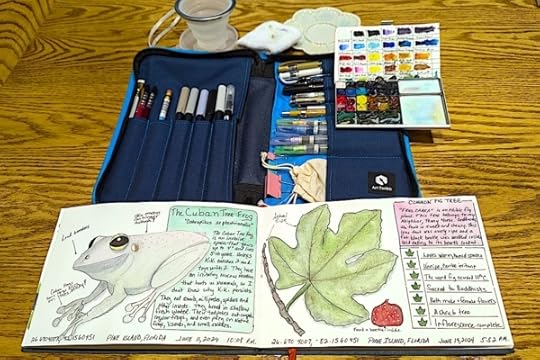
Nature art journals are a great way to express creativity and document the natural and wild places you visit. When you illustrate them, they become visual journals where you record your experiences, events, feelings, and new things you’ve learned.
While traveling, you become more mindful of everything you see, taste, or feel. The same is true when making art.
When you take the time to sit down and make art, you’re forced to slow down and pay attention to your surroundings. This act of mindfulness can help you be more present in the moment and appreciate the beauty of your surroundings in a way that you might not otherwise.
What are the benefits of art journaling?
It can help you to improve your drawing skills.It can help you to learn about your surroundings.It can help you to connect with your community.It can be a fun and relaxing way to spend time outdoors.It can be a great way to document your travels.You only need a few tools to get started. Keep your art kit basic and start with a simple subject. Be bold and embrace mistakes—they’re part of the fun!
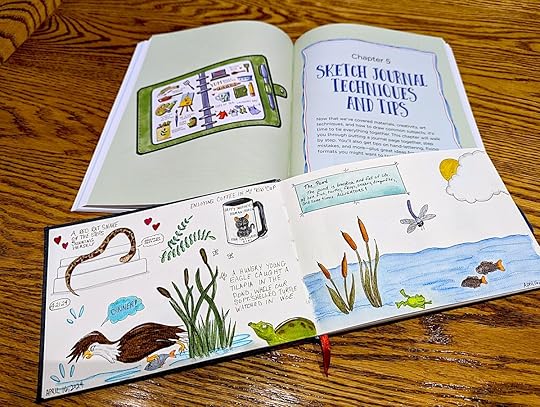
Here are some tips for choosing easy-to-use art supplies while traveling:
Choose a sketchbook that you love. Your sketchbook will be your travel companion, so choosing one you love is essential. Look for a sketchbook that is the right size, has good paper, and is durable.Pack a travel palette to keep your paints organized and easily accessible. Many travel palettes are available, so you can choose one that fits your needs and budget.Practice painting at home before you travel. This will help you get used to using your supplies and ensure your comfort with the process.Bring a small water container—a bottle, a small cup, and a travel water brush. You’ll need water to wet your brushes and mix your paints.Pack essential tools, such as a pencil, eraser, and sharpener. If you plan on doing detailed work, you could also bring a ruler or a compass.Pack your supplies in a waterproof container. This will protect them from getting wet in transit.Consider packing a folding watercolor easel. This will give you a stable surface, even if you paint outdoors.Don’t be afraid to experiment. There are no rules when it comes to art travel journals. Experiment with different mediums, techniques, and subjects. The more you experiment, the more you’ll learn and improve.Finally, remember to pack your creativity! Art journaling is a great way to capture travel memories and express your artistic side. Enjoy the process, and let your creativity flow.
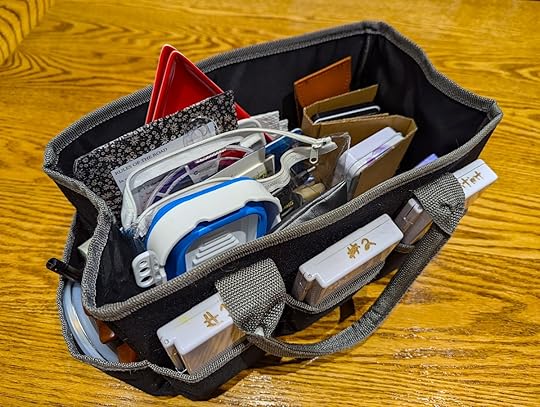
I keep a few different art kits ready to go. When I’m traveling locally, especially if I’m driving to visit family, I use my large art kit. I keep all the tools I need in this handy bag.
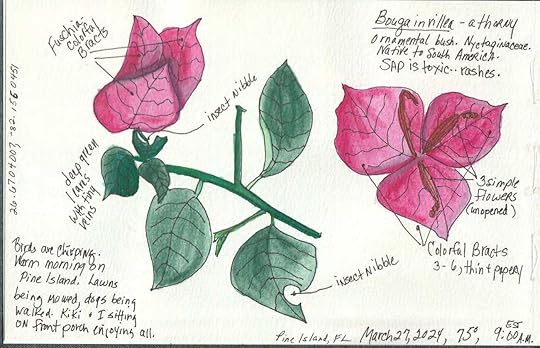
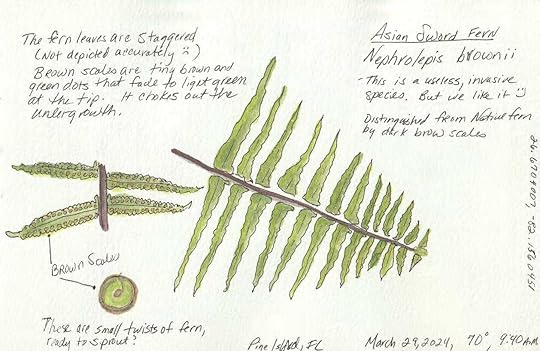
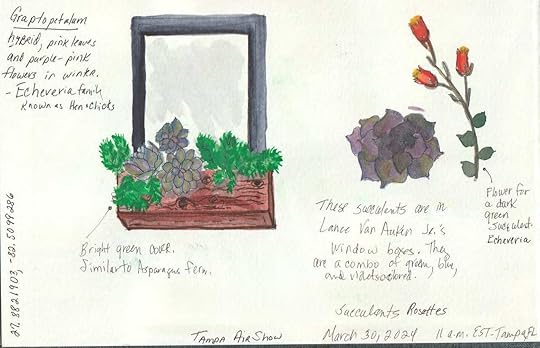




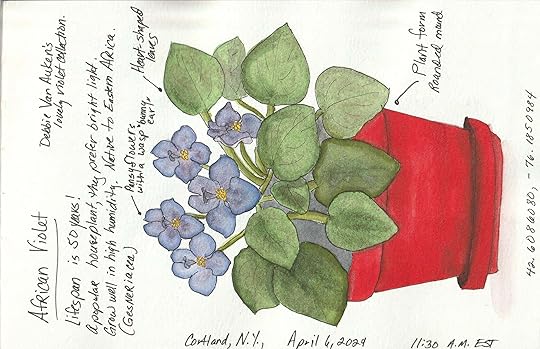
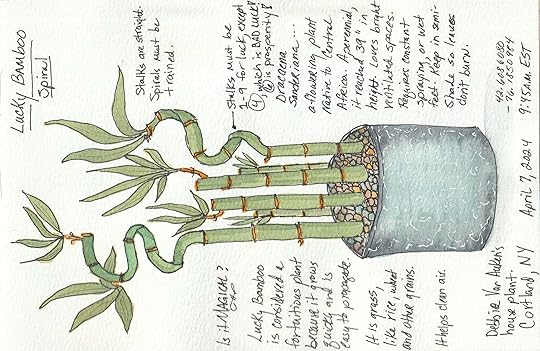
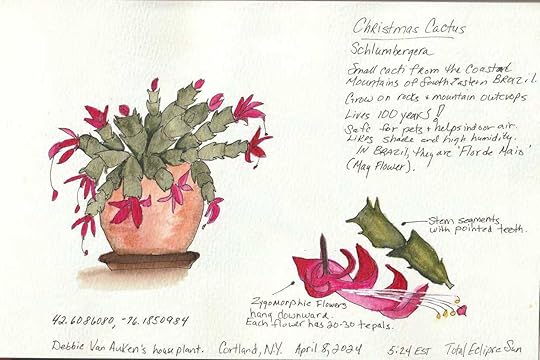
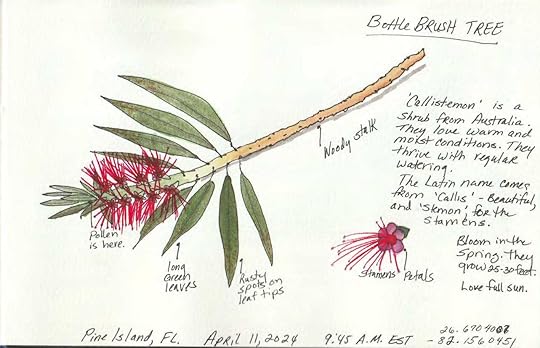

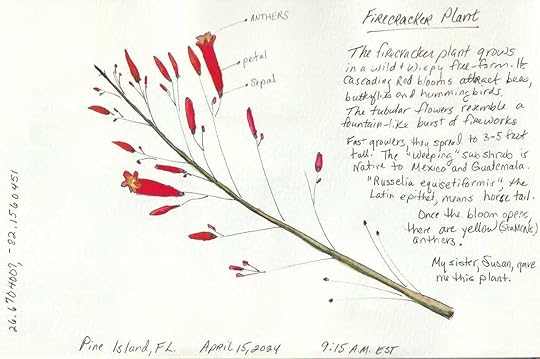

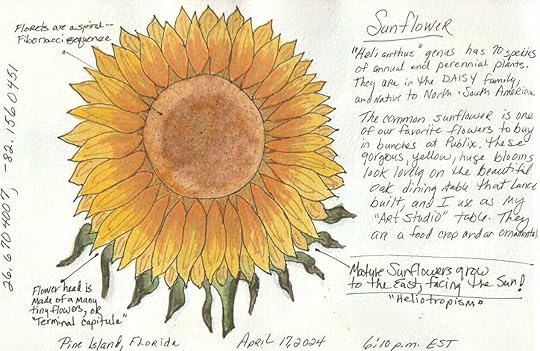
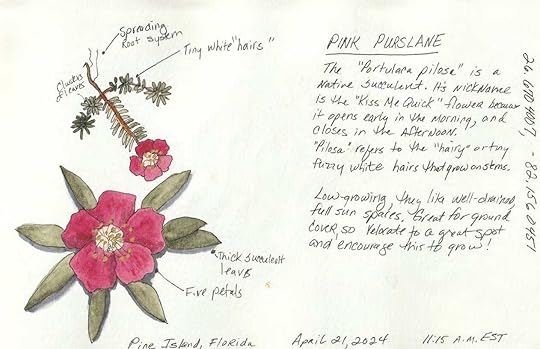

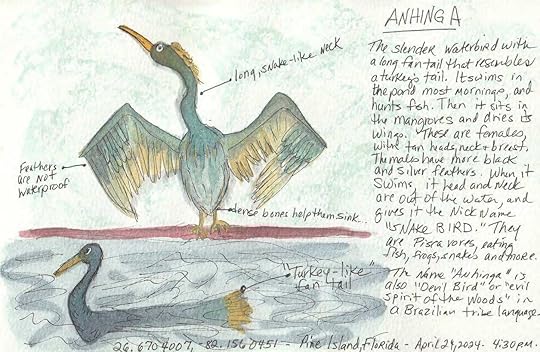

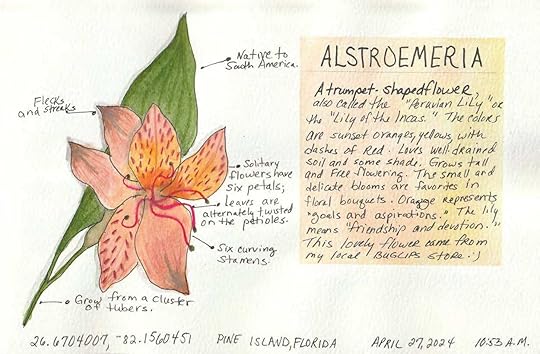

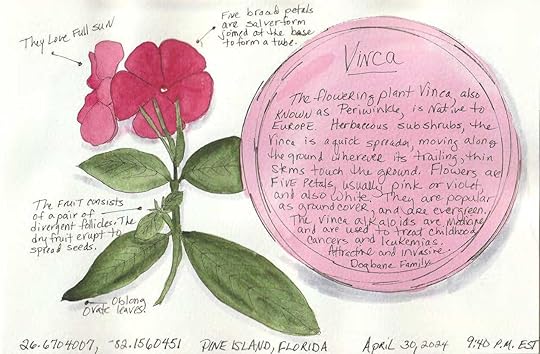
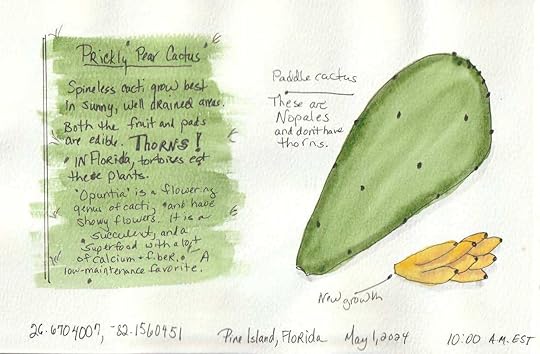

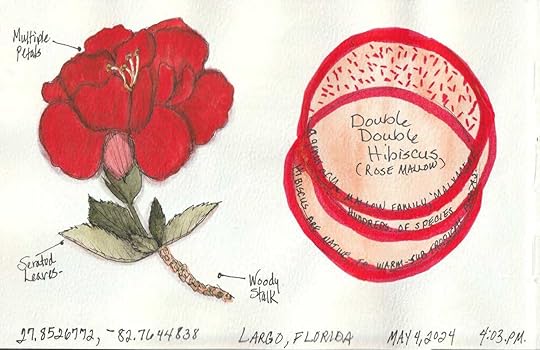

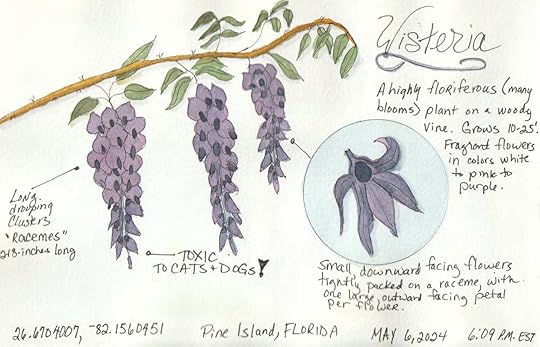
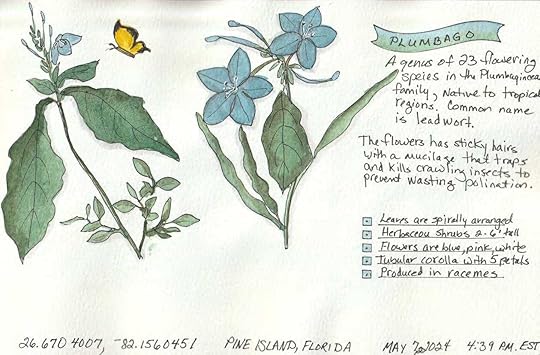
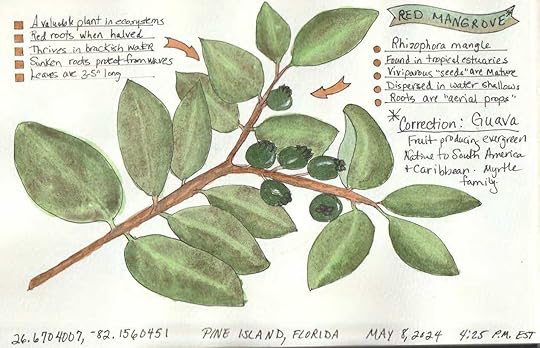

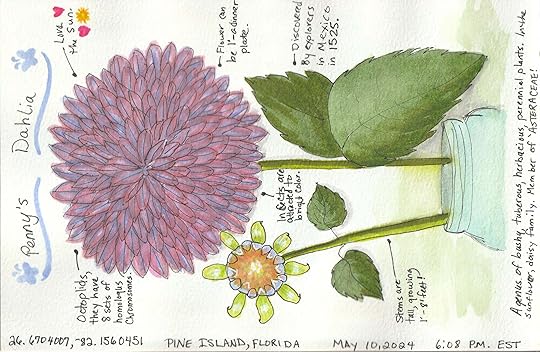
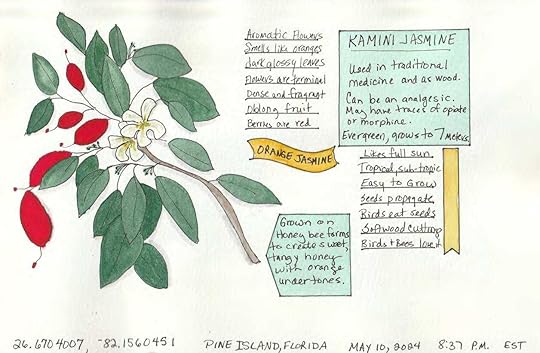



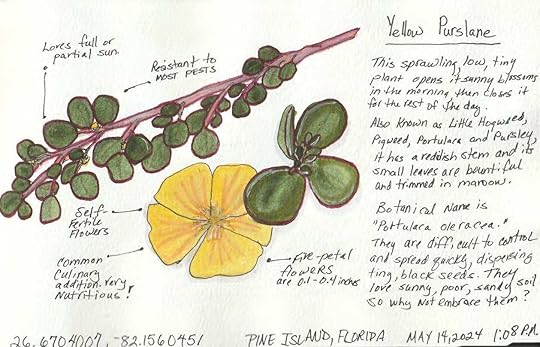
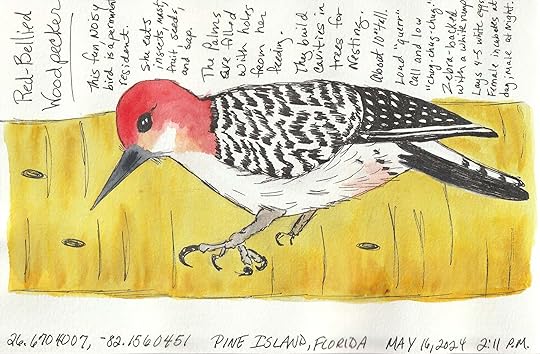

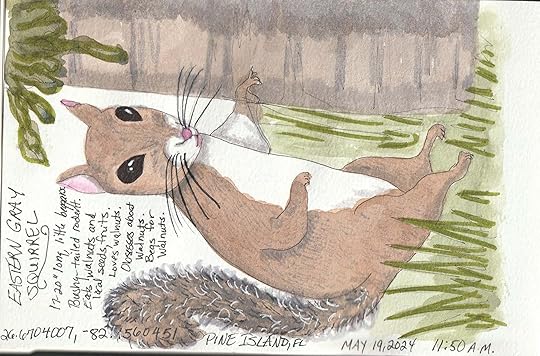
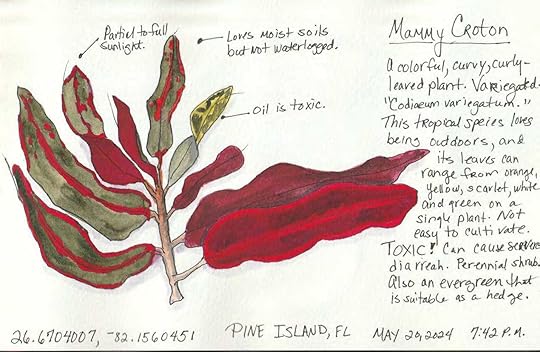


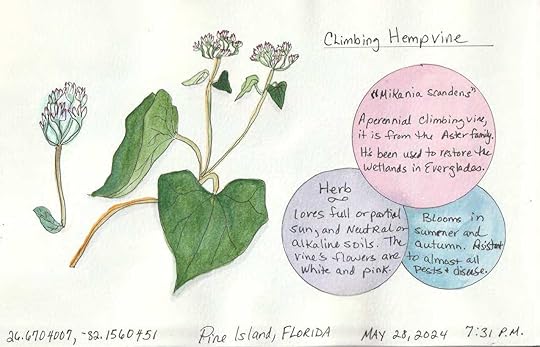
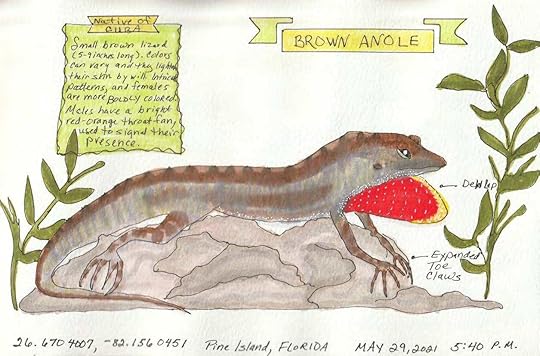

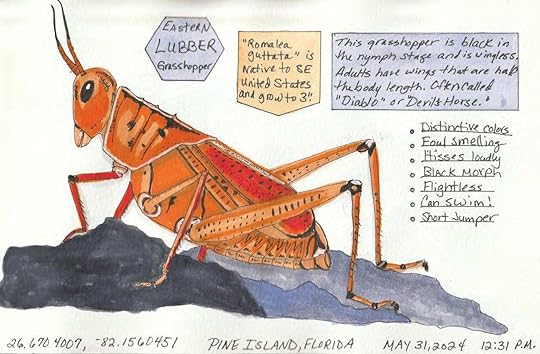
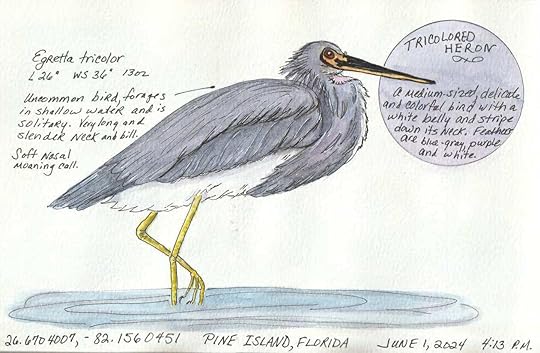
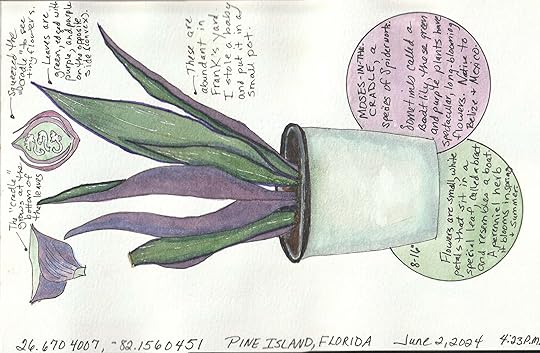
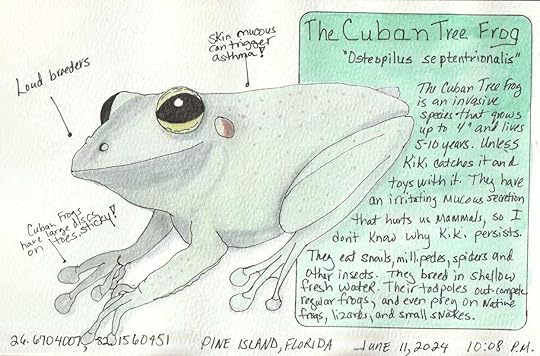
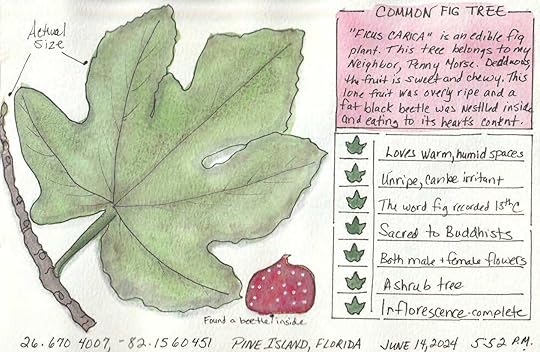
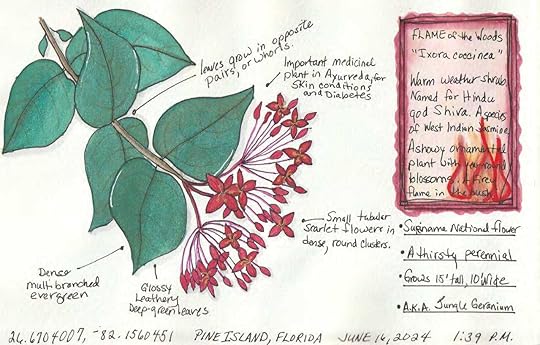




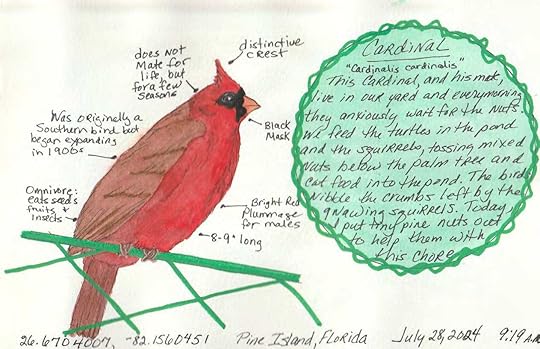



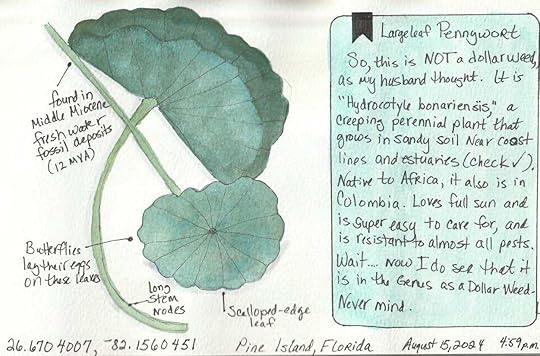


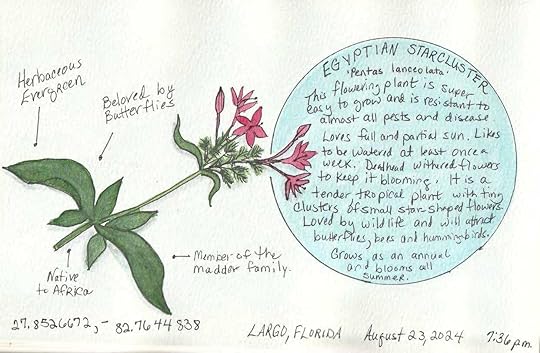







 Ready for a Challenge?
Ready for a Challenge?
 Accept the Challenge
Accept the ChallengeHave even more fun when you accept the 21-Day Writing Sprint Challenge. This process is one I use every semester with my college students, so I know it can kickstart your creativity and introduce structure to your writing schedule. When you join my Circle of Writers & Authors, you’ll receive FREE writing resources, and you’ll sign up for my newsletter. I will not sell your information, or spam you. I will send you updates about new articles and podcasts I’ve created, and projects I’m working on. You can unsubscribe at anytime. Read my Privacy Policy here.
Wholehearted Author is for you if you are …Starting out as a writer and could use some guidanceWanting to be inspired to create and publish your bookLooking for like-minded, happy people and helpful mentorsHoping to turn your writing into a full-time, awesome careerNew to the concept of “permission marketing” but willing to try Send My Free Writing ResourcesCATCH THE WEST WINDAdd WEST WIND to your library!
Send My Free Writing ResourcesCATCH THE WEST WINDAdd WEST WIND to your library!If you love a good mystery, a romantic whodunit that will surprise you, then WEST WIND is a great addition to your ebook library.
West Wind is my third novel as an author of Contemporary Fiction, Suspense, Thriller, and Romance. It’s FREE too, when you join my exclusive Readers Group. Join today and download your free book, and as a special thank you, you’ll receive a SECOND FREE BOOK tomorrow! The giving goes on and on when you become my fan.
When you join my Readers Group, you’ll receive updates about new projects I’m working on. You can unsubscribe at anytime. Read my Privacy Policy here.
 DOWNLOAD WEST WIND
DOWNLOAD WEST WINDThe post Have You Tried Nature Art Journaling? appeared first on Hands-on Heritage.
Have You Tried Art Journaling?
Next time you plan a trip, take an art journal. Regardless of your skill level, making art on the road will give you a more profound experience of your trip.

Art journals are a great way to express creativity and document the places you visit. When you illustrate them, they become visual journals where you record your experiences, events, feelings, and new things you’ve learned.
While traveling, you become more mindful of everything you see, taste, or feel. The same is true when making art.
When you take the time to sit down and make art, you’re forced to slow down and pay attention to your surroundings. This act of mindfulness can help you be more present in the moment and appreciate the beauty of your surroundings in a way that you might not otherwise.
What are the benefits of art journaling?
It can help you to improve your drawing skills.It can help you to learn about your surroundings.It can help you to connect with your community.It can be a fun and relaxing way to spend time outdoors.It can be a great way to document your travels.You only need a few tools to get started. Keep your art kit basic and start with a simple subject. Be bold and embrace mistakes—they’re part of the fun!

Here are some tips for choosing easy-to-use art supplies while traveling:
Choose a sketchbook that you love. Your sketchbook will be your travel companion, so choosing one you love is essential. Look for a sketchbook that is the right size, has good paper, and is durable.Pack a travel palette to keep your paints organized and easily accessible. Many travel palettes are available, so you can choose one that fits your needs and budget.Practice painting at home before you travel. This will help you get used to using your supplies and ensure your comfort with the process.Bring a small water container—a bottle, a small cup, and a travel water brush. You’ll need water to wet your brushes and mix your paints.Pack essential tools, such as a pencil, eraser, and sharpener. If you plan on doing detailed work, you could also bring a ruler or a compass.Pack your supplies in a waterproof container. This will protect them from getting wet in transit.Consider packing a folding watercolor easel. This will give you a stable surface, even if you paint outdoors.Don’t be afraid to experiment. There are no rules when it comes to art travel journals. Experiment with different mediums, techniques, and subjects. The more you experiment, the more you’ll learn and improve.Finally, remember to pack your creativity! Art journaling is a great way to capture travel memories and express your artistic side. Enjoy the process, and let your creativity flow.

I keep a few different art kits ready to go. When I’m traveling locally, especially if I’m driving to visit family, I use my large art kit. I keep all the tools I need in this handy bag.
Ready for a Challenge? Accept the Challenge
Accept the ChallengeHave even more fun when you accept the 21-Day Writing Sprint Challenge. This process is one I use every semester with my college students, so I know it can kickstart your creativity and introduce structure to your writing schedule. When you join my Circle of Writers & Authors, you’ll receive FREE writing resources, and you’ll sign up for my newsletter. I will not sell your information, or spam you. I will send you updates about new articles and podcasts I’ve created, and projects I’m working on. You can unsubscribe at anytime. Read my Privacy Policy here.
Wholehearted Author is for you if you are …Starting out as a writer and could use some guidanceWanting to be inspired to create and publish your bookLooking for like-minded, happy people and helpful mentorsHoping to turn your writing into a full-time, awesome careerNew to the concept of “permission marketing” but willing to try Send My Free Writing ResourcesCATCH THE WEST WINDAdd WEST WIND to your library!
Send My Free Writing ResourcesCATCH THE WEST WINDAdd WEST WIND to your library!If you love a good mystery, a romantic whodunit that will surprise you, then WEST WIND is a great addition to your ebook library.
West Wind is my third novel as an author of Contemporary Fiction, Suspense, Thriller, and Romance. It’s FREE too, when you join my exclusive Readers Group. Join today and download your free book, and as a special thank you, you’ll receive a SECOND FREE BOOK tomorrow! The giving goes on and on when you become my fan.
When you join my Readers Group, you’ll receive updates about new projects I’m working on. You can unsubscribe at anytime. Read my Privacy Policy here.
 DOWNLOAD WEST WIND
DOWNLOAD WEST WINDThe post Have You Tried Art Journaling? appeared first on Hands-on Heritage.
March 27, 2022
Finding Fossils on the Isle of Wight
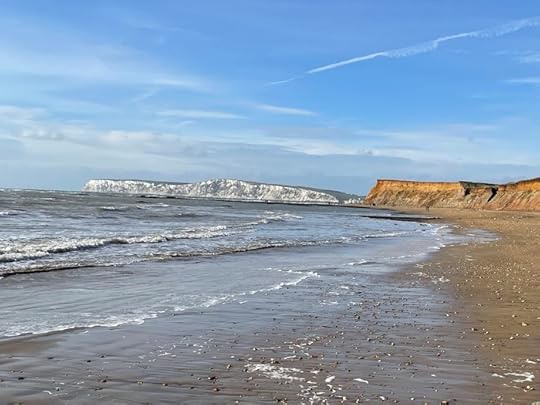 Sunny days are rare in the UK, but this February morning is bright and beautiful at Compton Bay on the Isle of Wight. The white chalk cliffs of Freshwater rise in the distance. – Photo by Robin Van Auken
Sunny days are rare in the UK, but this February morning is bright and beautiful at Compton Bay on the Isle of Wight. The white chalk cliffs of Freshwater rise in the distance. – Photo by Robin Van AukenWhen you stroll the beach on the Isle of Wight and the light bounces off a dark shiny object above the tidal line, chances are it is a fossil, not a shell. Pick it up.
It could be from a spinosaur, the largest carnivorous predator to hunt the landmass that eventually became Europe. According to the Natural History Museum in London, the Isle’s spinosaurs are possibly 10-plus meters long – nearly 33 feet long!
We visit Compton Bay on the Isle of Wight on a bright and brisk day in February, about 125 million years after the dinosaur, whose bone I now cradle in my hand. As I turn it over, I see veins of brassy gold and a few boxy crystals. I recognize it as pyrite, a mineral often called “Fool’s Gold.”
I carefully slide it into my backpack and keep strolling the rocky coast of Compton Bay, my eyes scanning from left to right. I search for the famous dinosaur footprints on the sandstone ledge at Hanover Point. I soon find billowy gray casts exposed by the low tide. Cartoon-like, three enormous Iguanodon toes emerge from the sand. Then three more. The tracks march across the beach.
How did such massive dinosaurs end up on a small island off the southern tip of England?
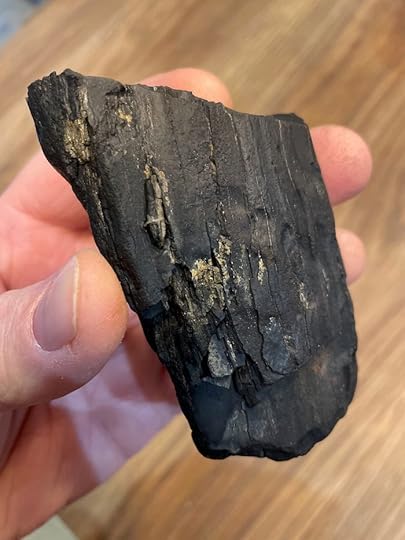 Finding authentic dinosaur fossils is easy and thrilling at Compton Bay on the Isle of Wight. Here, the author examines a 125 million-year-old bone. – Photo by Robin Van Auken
Finding authentic dinosaur fossils is easy and thrilling at Compton Bay on the Isle of Wight. Here, the author examines a 125 million-year-old bone. – Photo by Robin Van Auken Pyrite is a brassy gold mineral that fills in the crevices of a bone as it turns from organic material to a stony fossil. This process is possible because the animal died in a swampy, low-oxygen location, or a flash flood covered its skeletal remains. – Photo by Robin Van AukenLand Before Time
Pyrite is a brassy gold mineral that fills in the crevices of a bone as it turns from organic material to a stony fossil. This process is possible because the animal died in a swampy, low-oxygen location, or a flash flood covered its skeletal remains. – Photo by Robin Van AukenLand Before TimeScientists discovered more than 20 species of dinosaurs on the Isle of Wight in a layer of sediment called the Vectis Formation. They lived in a subtropical environment. Good for us because those conditions are the best conditions to form fossils.
The dinosaur bones were preserved because they were buried in stagnant ponds with low oxygen. The chemical processes that occur when minerals replace the organic matter create the fossil. During this time, pyrite fills the gaps in the bone. Fine pyrite makes it appear black, while larger pyrite emerges as gold streaks and cubes.
This time is known as the Cretaceous geological period, lasting from about 145 to 66 million years ago. It was during the Cretaceous (not the Jurassic) that the Tyrannosaurus rex arose. Then, over 85 million years ago, T Rex thrived as a top land predator. Now, we see them brought to animatronic life in museums, wearing colorful jumpers (sweaters) at Christmas.
Eventually, our backpacks are heavy, and we’re satisfied with the hours we spent strolling the two miles of Compton Beach. In the distance, the white chalk cliffs at Freshwater reflect the sun’s low angle, and we climb back to the road to catch our bus.
It’s been an exciting day for amateur paleontologists!
 Visitors to Compton Bay not only visit for the fossils but they search for the Iguanodon footprints left behind. These large, three-toed casts are visible at low tide along Hanover Point. – Photo by Robin Van AukenCan you spot the Iguanodon footprint along the foreshore at Compton Bay? The National Trust protects them, and the removal is forbidden at Compton Bay, although smaller fossils scattered nearby are free to take. Iguanodon was the largest, best known, and most widespread of all the iguanodontids and is related to the hadrosaurs, or duck-billed dinosaurs. They averaged 30 feet long and weighed four to five tons. The formidable T-Rex doesn’t appear as fearsome in its holiday jumper. The animatronic dinosaur is part of the Natural History Museum display. – Photo by Robin Van Auken
Visitors to Compton Bay not only visit for the fossils but they search for the Iguanodon footprints left behind. These large, three-toed casts are visible at low tide along Hanover Point. – Photo by Robin Van AukenCan you spot the Iguanodon footprint along the foreshore at Compton Bay? The National Trust protects them, and the removal is forbidden at Compton Bay, although smaller fossils scattered nearby are free to take. Iguanodon was the largest, best known, and most widespread of all the iguanodontids and is related to the hadrosaurs, or duck-billed dinosaurs. They averaged 30 feet long and weighed four to five tons. The formidable T-Rex doesn’t appear as fearsome in its holiday jumper. The animatronic dinosaur is part of the Natural History Museum display. – Photo by Robin Van Auken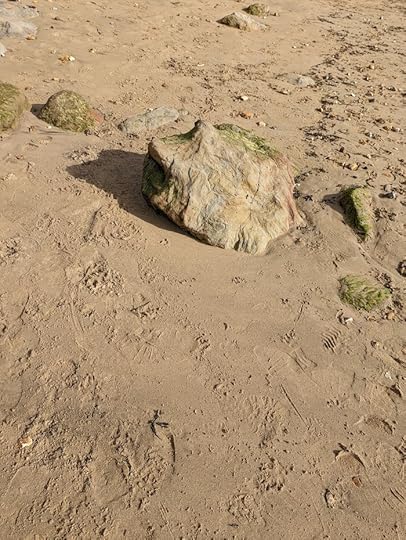
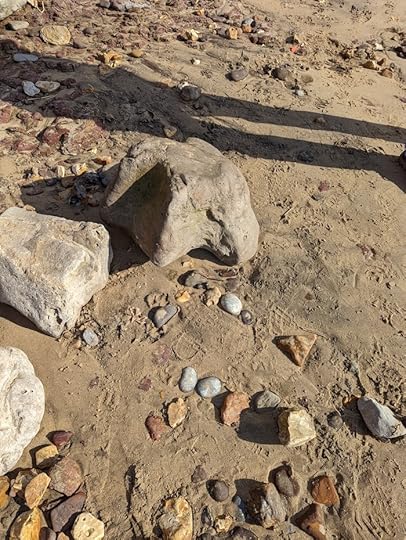
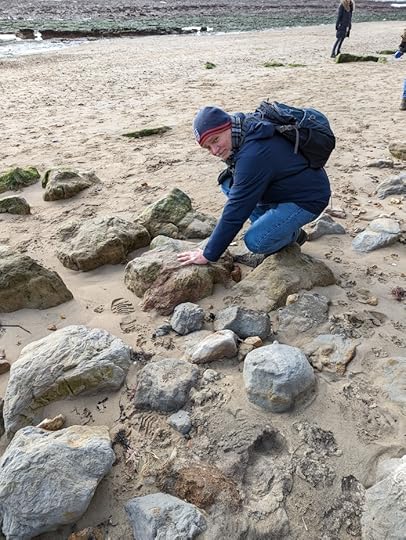
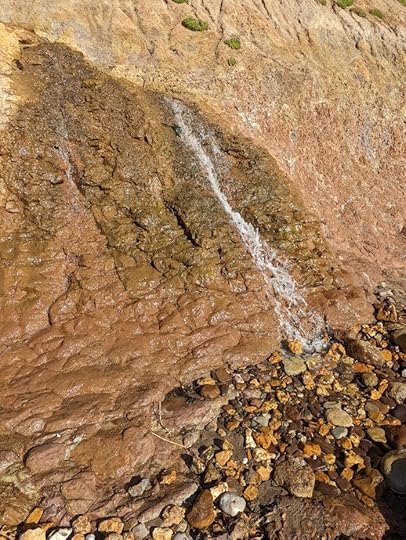

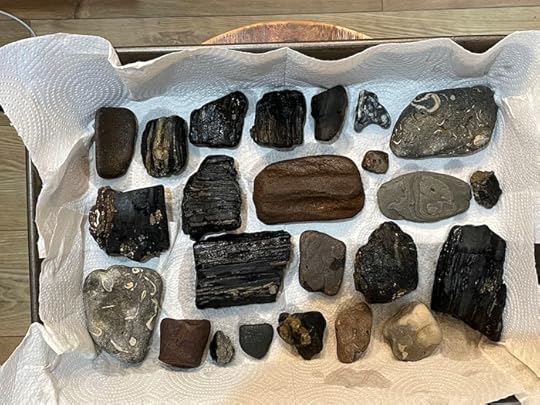 Amazing finds! The author shares her collection of dinosaurs and other animal fossils found at Compton Bay, Isle of Wight. – Photo by Robin Van AukenDay Tripping to the Isle of Wight
Amazing finds! The author shares her collection of dinosaurs and other animal fossils found at Compton Bay, Isle of Wight. – Photo by Robin Van AukenDay Tripping to the Isle of WightThe trip to the island concludes a three-month-long sojourn in England. We’ve traveled to Southhampton, waiting to board the Queen Mary 2 for a trans-Atlantic journey to New York.
Southampton, an eclectic city that rebuilt and reinvented itself after the horrific bombing in World War II, is a story for another day. Today, we’re catching the Red Jet to the Isle of Wight.
It’s a short walk to the high-speed ferry terminal, but the cold wind buffets me, whipping my scarf behind me and bringing tears to my eyes. Once we arrive, we purchase “Day Return” tickets for same-day trips to and from West Cowes. These are about £32 ($40). With our passes in our pockets, we order hot chocolate and await the boat’s arrival. Finally, we trundle aboard for a 30-minute trip across the Solent.
Our ferry is Red Jet 6, the company’s largest high-speed catamaran with a capacity of 275 passengers and four crew. Some passengers bring bicycles with them, some have baby strollers, but most are on foot, like us. Quite a few have their dogs on leashes. The people of the UK love their dogs and take them nearly everywhere.
The Red Funnel company provides a designated pet lounge with water bowls on several ferries. Dogs are always welcome on the outer passenger decks. If you’re traveling with a pet and want to visit the “Isle of Woof,” look at this information from Red Funnel about pet-friendly sites.




 Southampton was the departure point for the RMS Titanic. The Cunard Line maintains a regular transatlantic service to New York from the city, and the Queen Mary 2 awaits in the distance. Red Funnel ferries transport people (and their vehicles) to and from the Isle of Wight daily. Each year, it carries 3.4 million passengers. With 35 ferries from Southampton to the Isle of Wight daily, foot passengers appreciate fewer than 30 minutes of crossing time. Vehicle ferry crossing times average 60 minutes. – Photo by Robin Van Auken
Southampton was the departure point for the RMS Titanic. The Cunard Line maintains a regular transatlantic service to New York from the city, and the Queen Mary 2 awaits in the distance. Red Funnel ferries transport people (and their vehicles) to and from the Isle of Wight daily. Each year, it carries 3.4 million passengers. With 35 ferries from Southampton to the Isle of Wight daily, foot passengers appreciate fewer than 30 minutes of crossing time. Vehicle ferry crossing times average 60 minutes. – Photo by Robin Van AukenOnly some people who travel to the Isle of Wight are heading to Compton Bay, as we were. It’s a popular holiday destination with 57 miles of coastline, 20 beaches, and an array of protected woodland and nature reserves. There are more than 50 attractions and places to visit. If you think a visit might be upcoming, you can check Red Funnel’s guide and save up to 25% of your travel costs.
Because we are day-trippers, we follow the well-marked path to the local bus station and await our next mode of transportation. We’ve discovered that Google Maps is an outstanding resource, even better than official-UK transportation apps that the locals use. In addition, Google gives us detailed information about public transportation when we’re abroad, so we don’t have to worry about cultural miscues or time differences.
We have a while before the next bus to Compton Bay, so we grab a breakfast sandwich and coffee. I should have skipped the coffee. There are no facilities at Compton Bay. During the tourist season, there are food vendors but no bathrooms. After arriving at the beach and walking around for a couple of hours looking for dinosaur fossils, the inevitable occurs. You need a restroom, but none are available for a couple of miles. If you’re an intrepid traveler, you can find a suitable niche in the multi-colored cliffs along the beach. No worries – high tide happens twice a day.
After our day of collecting fossils, we head back to the main road and the bus stop. We have two choices: We can catch a bus back to West Cowes and find a lovely restaurant for dinner before catching the return ferry, or we can walk a couple of miles along the narrow country road to the Sun Inn, a 16th-century thatched free house pub, and order a pint. (In Britain, a free house is a pub not owned by a particular company and can sell whatever beers it chooses.) There’s a second bus stop near the pub.
The road is narrow, and the shoulders are muddy when we have to move for the occasional passing car, but it is scenic. We see quaint cottages and mansions on the hill. We meet sheep who rush to the gate to greet us. Finally, we arrive at the pub, staffed by a calm Golden Retriever, and enjoy a lager. We would love to spend more time here, perhaps even have dinner, but we opt to catch the bus back to West Cowes while the sun is still shining.
Soon we are back at the ferry port and sail back to Southampton, where the choice of restaurants is enormous. But that, also, is another story.





 Curious sheep rush to the gate to greet us as we wander down a country lane on the Isle of Wight. Along the route, we notice a traditional thatched roof cottage, a rare sight in the United Kingdom because of the upkeep cost. Fewer people can afford mansions in the United Kingdom, but at least the roof is solid stone. We soon arrive at the Sun Inn, a free-house pub built during the 16th century. It is a simple space with cold draughts on tap, a beer garden, and dining areas with outstanding views of the rolling countryside and Tennyson Down. Dogs are welcome everywhere in the United Kingdom, and we are greeted by a friendly Golden Retriever resting on the cool, centuries-old flagstones of the Sun Inn. After a day collecting dinosaur fossils on the Isle of Wight, a refreshing pint of beer hits the spot. Unfortunately, keeping on schedule means we can only have a couple of pints before catching the ferry back to Southampton. – Photo by Robin Van Auken
Curious sheep rush to the gate to greet us as we wander down a country lane on the Isle of Wight. Along the route, we notice a traditional thatched roof cottage, a rare sight in the United Kingdom because of the upkeep cost. Fewer people can afford mansions in the United Kingdom, but at least the roof is solid stone. We soon arrive at the Sun Inn, a free-house pub built during the 16th century. It is a simple space with cold draughts on tap, a beer garden, and dining areas with outstanding views of the rolling countryside and Tennyson Down. Dogs are welcome everywhere in the United Kingdom, and we are greeted by a friendly Golden Retriever resting on the cool, centuries-old flagstones of the Sun Inn. After a day collecting dinosaur fossils on the Isle of Wight, a refreshing pint of beer hits the spot. Unfortunately, keeping on schedule means we can only have a couple of pints before catching the ferry back to Southampton. – Photo by Robin Van AukenThe post Finding Fossils on the Isle of Wight appeared first on Hands-on Heritage.
November 18, 2020
Protective Magic: Say ‘Abracadabra’
Is there a defense against something you can’t see?
Today, we’re struggling through a pandemic, a deadly scourge that hasn’t been seen in the United States, or Europe, since the 1915 Spanish Flu. With a promising vaccine on the horizon, billions of people are relieved, excited, and eager to resume life.
We’re so lucky that we live in the future with modern medicine and brilliant scientists and researchers have found an answer to the Covid19 virus.
What would we do without them? What did people do in the past?
The roots of medicine are ancient, branching through the millennia to a time when people relied on local herbs and healing to treat ailments and wounds. At times, when these traditions failed, people turned to incantations and magic.
For example, a third-century CE treatment for malaria was to wear an amulet with the inscription “abracadabra” for nine days, then throw it over your shoulder into an eastward-running stream.
Do you wear talismans and charms? Do you have faith in rituals? In times of trouble, people turn to remedies and treatments that aren’t always recommended, but if they provide you comfort and don’t hurt anyone, then carry on. Just one request — wear a mask!
.fusion-image-frame-bottomshadow.image-frame-shadow-1{display:inline-block}.element-bottomshadow.imageframe-1:before, .element-bottomshadow.imageframe-1:after{-webkit-box-shadow: 0 17px 10px rgba(0,0,0,0.4);box-shadow: 0 17px 10px rgba(0,0,0,0.4);}

This “Cure for Memitertian Fever” is offered by Quintus Serenus Sammonicus (c. 370 CE–212 CE) in his manuscript Liber Medicinalis:
“Write several times on a piece of paper the word ‘Abracadabra,’ and repeat the words in the lines below but take away letters from the complete word and let the letters fall away one at a time in each succeeding line. Take these away ever, but keep the rest until the writing is reduced to a narrow cone. Remember to tie these papers with flax and bind them round the neck.”
The post Protective Magic: Say ‘Abracadabra’ appeared first on Hands-on Heritage.
November 11, 2020
Heart Stone an Enduring Inspiration
Are you fascinated by rocks? How about fossils, or artifacts? How we visualize, interpret, and transform the world around us has always interested me.
I try to be scientific and pragmatic with my actions, but one day my good friend Tonya Anderson asked me to reach into a bag and blindly pull out a stone that would “represent” my spirit.
I rolled my eyes.
Then I pulled out this magnificent brown and black stone that looks like a battered and worn, but enduring, heart.
It also has striations that make it look almost transparent when I placed it on my desk.
I keep this stone on my bookcase next to my workstation and look at it often. I am amazed that it still inspires me and, despite my realistic inclinations, I believe that it does represent my spirit.
I still thank Tonya for constantly reminding me to look for joy in unexpected marvels.
If you’re ever asked to place your hand in a bag and pull out an object that “speaks” to you, then listen — there may be a language you’ve never heard before.
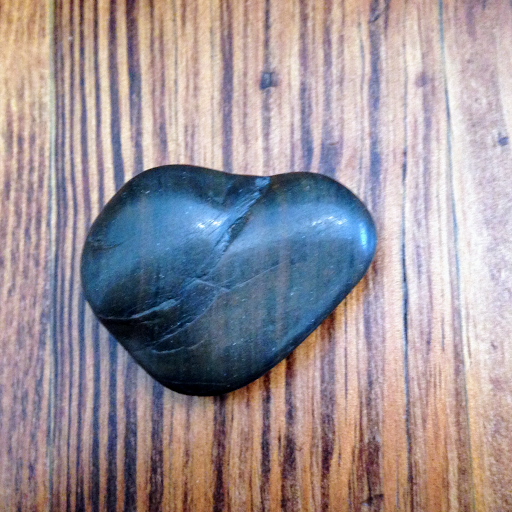
The post Heart Stone an Enduring Inspiration appeared first on Hands-on Heritage.
November 6, 2020
Sailing to Alcatraz Island
I found this historic postcard of Alcatraz Island on the Library of Congress while researching it for a recent project in California. I also sailed to the island located in San Francisco Bay one sunny day, enjoying a similar experience and perspective of the island as the crew on this boat (but getting there and back quickly thanks to the powerful diesel engines on the ferry).
It has a storied history.
The island has evolved from a Civil War-era military fort to a military prison, to a maximum-security federal penitentiary before becoming a national park. In 1969, Native Americans protesting for Civil Rights occupied the island for 19 months!
“The Rock” is now a quiet park that hosts tourists curious about its dark history, but few people realize its importance to nesting birds. Before the U.S. Government decided to build a fort and lighthouse on the island, it was a sanctuary for untold generations of seabirds. In fact, the original name of the white island was “Alcatraces” – Spanish for the “strange birds” they saw there.
Today, the birds have returned, and tourists can see Western gulls, cormorants and pigeon guillemots, and waterbirds such as snowy egrets and black-crowned night herons.
Click here to learn more about how the National Park Service has restored and shares Alcatraz Island with the public.

The post Sailing to Alcatraz Island appeared first on Hands-on Heritage.
August 8, 2020
Protective Magic: Incantation Bowls
Believing that malevolent forces caused tumors and other illnesses, Jewish communities in Mesopotamia created incantation bowls (c. 300–700 CE) to trap demons and protect the family.
Inscribed in Aramaic with spiraling spells and magical symbols, and placed upside down at the entrances of their homes, the incantation bowl restrained demons.
Some incantation bowls bestowed blessings and potency to medicines they held. Arabic incantation bowls were utilized in homes during the Mamlūk period (c. 1250–1517 CE) to ward off misfortune, abate a fever, and alleviate pain from diseases.
The belief was that water left overnight in an incantation bowl absorbed magical properties, enhancing its healing effect. They are inscribed with Arabic script, sometimes with Qur’ānic verses or supplications and simple exorcisms.
.fusion-image-frame-bottomshadow.image-frame-shadow-1{display:inline-block}.element-bottomshadow.imageframe-1:before, .element-bottomshadow.imageframe-1:after{-webkit-box-shadow: 0 17px 10px rgba(0,0,0,0.4);box-shadow: 0 17px 10px rgba(0,0,0,0.4);}

The post Protective Magic: Incantation Bowls appeared first on Hands-on Heritage.



